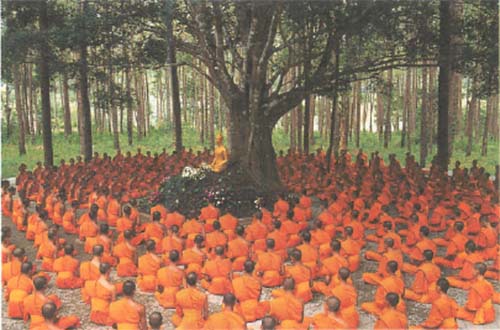
Ordination Traditions during the Time of Lord Buddha
In the early Buddhists era, all of Lord Buddha’s disciples were monks, without any novices. When young Prince Siddhattha was ordained, his ordination was referred to as “lower ordination”
(pabbajja), a term which nowadays is used to refer to novices who were ordained. However, he was already too old to be considered a novice. From the time Lord Buddha allowed novices to be
ordained, the ordination of monks became known as higher ordination or (upasampadd).
The very first novice ordained during the time of Lord Buddha, was his son Rahula. He was ordained when Buddha returned to his hometown of Kapilavatthu, to give a sermon to his parents and relatives. The reason Rahula became a novice was due to his mother’s encouragement for him to seek out Buddha, and asked him for his inheritance and throne, over which Lord Buddha could still lay claim despite his being a monk.Lord Buddha felt that his son deserved more than mere worldly riches, and that his son deserved true happiness, which was worth more than all the world’s riches. Lord Buddha asked Sariputta, a disciple, to ordain Rahula as a novice according to the ritual of “ Taking the Three Refuges” Ever since then, Taking Refuge has remained the standard by
which all novices are ordained, even to this day.
The process of ordaining novices according by “Taking Refuge” entails the following: Novices must have their heads and moustache shaved and don saffron robes. After that, they must pay respect to their preceptor, in order to seek permission to be ordained as a novice. The preceptor then leads the novice in a chanting ceremony to remind the novice of the Triple Gem. The novice must then respond with his own chant taking refuge in the Triple Gem. As follows.
I take refuge in Lord Buddha
I take refuge in the Teaching
I take refuge in the Monastic Order
For a second time I take refuge in Lord Buddha
For a second time I take refuge in the Teaching
For a second time I take refuge in the Monastic Order
For a third time I take refuge in Lord Buddha
For a third time I take refuge in the Teaching
For a third time I take refuge in the Monastic Order
The reason for the three repetitions is due to the fact that sometimes, we say things without
paying careful attention to our own words. The purpose of these repetitions is to ensure that the
novice fully understands what he is saying. Following the chanting, for the novice to become fully
ordained, he must then take the Ten Precepts, which are:
1. Abstaining from killing
2. Abstaining from stealing
3. Abstaining from sexual behavior
4. Abstaining from lying speech
5. Abstaining from consuming substances which cloud die mind
6. Abstaining from eating meals after midday
7. Abstaining from singing and dancing and other activities that may lead you to temptation
8. Abstaining from immodest dressing and appearance
9. Abstaining from indolent sleeping habits
10. Abstaining from accepting gifts or money for personal gam
Even though the novices’ordination entails only “ Taking Refuge,” the ten precepts serve as
important guidelines for personal conduct. Should any novice break any of these precepts,
especially the first five, then the novicehood will then be taken away from him, and he will no
longer be entitled to novicehood.
The act of ordaining has been in existence since the very beginning of the Buddhist era. shortly
after reaching enlightenment, Lord Buddha ordained his disciples himself. This act was called
‘ehi-bhikkhu' higher ordination’- Lord Buddha declared:
“Become a monk, for the Dhamma is good. We must cleanse ourselves so that we may be free from all worldly suffering” The first monk ordained by the Buddha personally, was Kondanna. He was the first of Lord Buddha’s
disciples, and Buddhism’s first monk. He was ordained following Lord Buddha’s first Sermon
entitled the Dhammacakkapavattana Sutta given in a deer forest known as Isipatana. The Buddha’s sermon brought upon Kondanna a revelation, and allowed him to see the light of the Dhamma, thus allowing him to become a Stream-enterer, or holy one.
Later on, Lord Buddha gave permission to monks’ ordination using “ Taking Refuge,” which is based on the same ceremony for novices-the difference being the number of precepts that Monks must abide by. In time, this process became known as ‘ordination by chanting of a motion’, which is used to this present day.